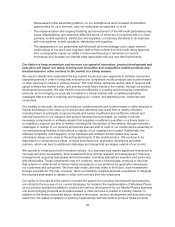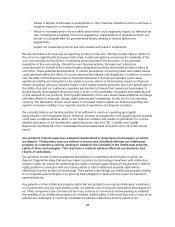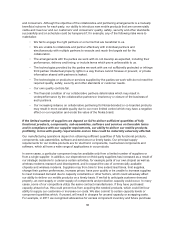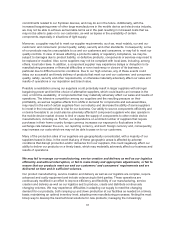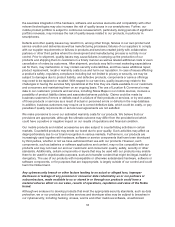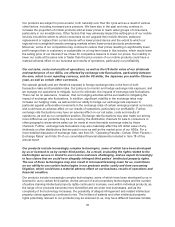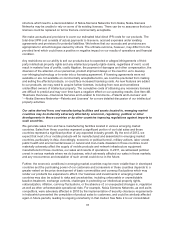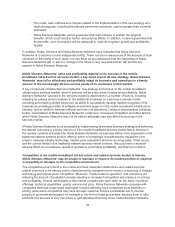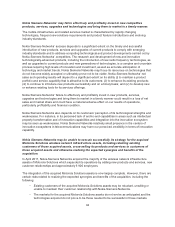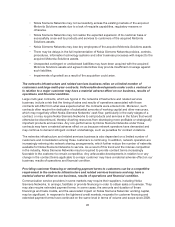Nokia 2011 Annual Report Download - page 37
Download and view the complete annual report
Please find page 37 of the 2011 Nokia annual report below. You can navigate through the pages in the report by either clicking on the pages listed below, or by using the keyword search tool below to find specific information within the annual report.Our products are subject to price erosion, both naturally over their life cycle and as a result of various
other factors, including increased price pressure. We have also in the past and may continue to
increase the proportion of mobile products sold at lower prices to reach wider groups of consumers,
particularly in our smartphones. Other factors that may adversely impact the selling price of our mobile
devices include the extent to which consumers do not upgrade their mobile devices, postpone
replacement or replace their current device with a lower-priced device and the extent to which our
regional mix is weighted towards emerging markets where lower-priced products predominate.
Moreover, some of our competitors may continue to reduce their prices resulting in significantly lower
profit margins than is customary or sustainable on a long-term basis in this industry, which would lower
the selling price of our devices if we chose for competitive reasons to lower our prices. Our inability to
lower our costs at the same rate or faster than the price erosion of our mobile products could have a
material adverse effect on our business and results of operations, particularly our profitability.
Our net sales, costs and results of operations, as well as the US dollar value of our dividends
and market price of our ADSs, are affected by exchange rate fluctuations, particularly between
the euro, which is our reporting currency, and the US dollar, the Japanese yen and the Chinese
yuan, as well as certain other currencies.
We operate globally and are therefore exposed to foreign exchange risks in the form of both
transaction risks and translation risks. Our policy is to monitor and hedge exchange rate exposure, and
we manage our operations to mitigate, but not to eliminate, the impacts of exchange rate fluctuations.
There can be no assurance, however, that our hedging activities will be successful in mitigating the
impact of exchange rate fluctuations. In addition, significant volatility in the exchange rates may
increase our hedging costs, as well as limit our ability to hedge our exchange rate exposure in
particular against unfavorable movements in the exchange rates of certain emerging market currencies
and could have an adverse affect on our results of operations, particularly our profitability. Further,
exchange rate fluctuations may have an adverse affect on our net sales, costs and results of
operations, as well as our competitive position. Exchange rate fluctuations may also make our pricing
more difficult as our products may be re-routed by the distribution channels for sale to consumers in
other geographic areas where sales can be made at more favorable exchange rates by those
channels. Further, exchange rate fluctuations may also materially affect the US dollar value of any
dividends or other distributions that are paid in euro as well as the market price of our ADSs. For a
more detailed discussion of exchange risks, see Item 5A. “Operating Results—Certain Other Factors—
Exchange Rates” and Note 34 of our consolidated financial statements included in Item 18 of this
annual report.
Our products include increasingly complex technologies, some of which have been developed
by us or licensed to us by certain third parties. As a result, evaluating the rights related to the
technologies we use or intend to use is more and more challenging, and we expect increasingly
to face claims that we could have allegedly infringed third parties’ intellectual property rights.
The use of these technologies may also result in increased licensing costs for us, restrictions
on our ability to use certain technologies in our products and/or costly and time-consuming
litigation, which could have a material adverse effect on our business, results of operations and
financial condition.
Our products include increasingly complex technologies, some of which have been developed by us or
licensed to us by certain third parties. As the amount of such proprietary technologies and the number
of parties claiming intellectual property rights continues to increase, even within individual products, as
the range of our products becomes more diversified and we enter new businesses, and as the
complexity of the technology increases, the possibility of alleged infringement and related intellectual
property claims against us continues to rise. The holders of patents and other intellectual property
rights potentially relevant to our products may be unknown to us, may have different business models,
35


